Sulfur Impurities: The Overlooked Process in Volcanic Hazard Assessment
Abstract
:1. Introduction
2. S Occurrence and Behavior
3. Influence of Impurities on S Behavior and Volcanic Implications
- Organics/Hydrocarbons
- Hydrogen sulfide and persulfides
- Sulfur dioxide and sulfuric acid
- Halogens
- Ammonia
Recent Findings
4. Evidence of S Accumulation in the Absence of a Lake
5. Cyclic Degassing and Other Sources of Impurities
5.1. Quiescent Periods: Effective—Undetected or Unreported?
- Vulcano (Aeolian Islands, Italy)
- Campi Flegrei caldera (Italy)
6. Discussion and Future Routes
7. Conclusions
Supplementary Materials
Funding
Data Availability Statement
Acknowledgments
Conflicts of Interest
References
- Kawasaki, H. Genesis of sulphur on the volcano Shirane. J. Geol. Soc Tokio 1903, 10, 425–428. [Google Scholar]
- Ohashi, R. On the peculiar sulphur sperules produced in a crater lake of the volcano Shirane, in the province of Kozuke, central Japan. J. Akita Min. Coll 1919, 1, 1–10. [Google Scholar]
- Delmelle, P.; Bernard, A. The Remarkable Chemistry of Sulfur in Hyper-Acid Crater Lakes: A Scientific Tribute to Bokuichiro Takano and Minoru Kusakabe. In Volcanic Lakes; Rouwet, D., Christenson, B., Tassi, F., Vandemeulebrouck, J., Eds.; Springer: Berlin/Heidelberg, Germany, 2015; pp. 239–259. [Google Scholar]
- Fournier, N.; Moreau, M.; Robertson, R. Disappearance of a crater lake: Implications for potential explosivity at Soufrière volcano, St Vincent, Lesser Antilles. Bull. Volcanol. 2011, 73, 543–555. [Google Scholar] [CrossRef]
- Christenson, B.W.; Reyes, A.G.; Young, R.; Moebis, A.; Sherburn, S.; Cole-Baker, J.; Britten, K. Cyclic processes and factors leading to phreatic eruption events: Insights from the September 25 2007 eruption through Ruapehu Crater Lake, New Zealand. J. Volcanol. Geotherm. Res. 2010, 191, 15–32. [Google Scholar] [CrossRef]
- Mora-Amador, R.; Rouwet, D.; Vargas, P.; Oppenheimer, C. The extraordinary sulfur volcanism of Poás from 1828 to 2018. In Poas Volcano. Active Volcanoes of the World; Tassi, F., Vaselli, O., Mora-Amador, R., Eds.; Springer: Cham, Switzerland, 2019. [Google Scholar] [CrossRef]
- Takano, B.; Saitoh, H.; Takano, E. Geochemical implications of subaqueous molten sulfur at Yugama crater lake, Kusatsu-Shirane volcano, Japan. Geochem. J. 1994, 28, 199–216. [Google Scholar] [CrossRef]
- Ohba, T.; Hirabashi, J.I.; Nogami, K. Temporal changes in the chemistry of lake water within Yugama Crater, Kusatsu-Shirane Volcano, Japan: Implications for the evolution of the magmatic hydrothermal system. J. Volcanol. Geotherm. Res. 2008, 178, 131–144. [Google Scholar] [CrossRef]
- Oppenheimer, C.; Stevenson, D. Liquid sulphur lakes at Poás volcano. Nature 1989, 342, 790–793. [Google Scholar] [CrossRef]
- Edwards, M.J.; Kennedy, B.M.; Jolly, A.D.; Scheu, B.; Jousset, P. Evolution of a small hydrothermal eruption episode through a mud pool of varying depth and rheology, White Island, NZ. Bull. Volcanol. 2017, 79, 16. [Google Scholar] [CrossRef]
- Skinner, B.J. A sulfur lava flow on Mauna Loa. Pac. Sci. 1970, 24, 144–145. [Google Scholar]
- Colony, W.E.; Nordlie, B.E. Liquid sulfur at Volcan Azufre, Galapagos Islands. Econ. Geol. 1973, 68, 371–380. [Google Scholar] [CrossRef]
- Greeley, R.; Theililig, E.; Christensen, P. The Mauna Loa sulfur flow as an analog to secondary sulfur flows (?) on Io. Icarus 1984, 60, 189–199. [Google Scholar] [CrossRef]
- Naranjo, J.A. Sulphur flows at Lastarria volcano in the North Chilean Andes. Nature 1985, 313, 778–780. [Google Scholar] [CrossRef]
- Inostroza, M.; Fernandez, B.; Aguilera, F.; Layana, S.; Walter, T.R.; Zimmer, M.; Rodríguez-Díaz, A.; Oelze, M. Physical and chemical characteristics of active sulfur flows observed at Lastarria volcano (northern Chile) in January 2019. Front. Earth Sci. 2023, 11, 1197363. [Google Scholar] [CrossRef]
- Luhr, J.F.; Carmichael, I.S.E.; Varekamp, J.C. The 1982 eruptions of El Chichón Volcano, Chiapas, Mexico: Mineralogy and petrology of the anhydrite bearing pumices. J. Volcanol. Geotherm. Res. 1984, 23, 69–108. [Google Scholar] [CrossRef]
- Francis, P.; Oppenheimer, C.; Stevenson, D. Endogenous growth of persistently active volcanoes. Nature 1993, 366, 554–557. [Google Scholar] [CrossRef]
- Wallace, P.; Gerlach, T.M. Magmatic vapor source for sulfur dioxide released during volcanic eruptions: Evidence from Mount Pinatubo. Science 1994, 265, 497–499. [Google Scholar] [CrossRef] [PubMed]
- Gerlach, T.M.; Westrich, H.R.; Symonds, R.B. Preeruption vapor in magma of the climactic Mount Pinatubo eruption: Source of the giant stratospheric sulfur dioxide cloud. In Fire and Mud, Eruptions and Lahars of Mount Pinatubo, Philippines; Newhall, C., Punongbayan, A.S., Eds.; USGS-PHYVOLC: Sioux Falls, SD, USA, 1996. [Google Scholar]
- Christenson, B.W.; Wood, C.P. Evolution of a vent-hosted hydrothermal system beneath Ruapehu Crater Lake, New Zealand. Bull. Volcanol. 1993, 55, 547–565. [Google Scholar] [CrossRef]
- Yaguchi, M.; Ohba, T.; Terada, A. Groundwater Interacting at Depth with Hot Plastic Magma Triggers Phreatic Eruptions at Yugama Crater Lake of Kusatsu-Shirane Volcano (Japan). Front. Earth Sci. 2022, 9, 741742. [Google Scholar] [CrossRef]
- Lewis, D. Science agency on trial following deadly White Island volcano eruption. Nature 2021, 598, 243–244. [Google Scholar] [CrossRef]
- Werner, C.; Hurst, T.; Scott, B.; Shernburn, S.; Christenson, B.W.; Britten, K.; Cole-Baker, J.; Mullan, B. Variability of passive gas emissions, seismicity, and deformation during crater lake growth at White Island Volcano, New Zealand 2002–2006. J. Geophys. Res. 2008, 113. [Google Scholar] [CrossRef]
- Scolamacchia, T.; Cronin, S.J. Idiosyncrasies of volcanic sulfur viscosity and the triggering of unheralded volcanic eruptions. Front. Earth Sci. 2016, 4, 24. [Google Scholar] [CrossRef]
- Scolamacchia, T. Impurity of Sulfur Layers and Magmatic Gas Scrubbing: Implications for Gas Monitoring. In Proceedings of the AGU Fall Meeting 2017, New Orleans, LA, USA, 11–15 December 2017; p. V33D-2658. Available online: https://www.authorea.com/doi/full/10.1002/essoar.b76b5f07a2ad5d2b.bbbc5c50caaa4b91.1 (accessed on 1 November 2023). (In Authorea).
- Montanaro, C.; Mick, E.; Salas-Navarro, J.; Caudron, C.; Cronin, S.J.; de Moor, J.M.; Scheu, B.; Stix, J.; Strehlow, K. Phreatic and Hydrothermal Eruptions: From Overlooked to Looking Over. Bull. Volcanol. 2022, 84, 64. [Google Scholar] [CrossRef]
- Paillot-Bonnetat, S.; Raffin, V.; Harris, A.; Diliberto, I.S.; Ganci, G.; Cappello, A.; Bouoire, G.; Grassa, F.; Gattuso, A.; Ramsey, M. Anatomy of thermal unrest at a hydrothermal system: Case study of the 2021–2022 crisis at Vulcano. Earth Planets Space 2023, 75, 159. [Google Scholar] [CrossRef]
- Kürzinger, V.; Hansen, C.T.; Strauss, H.; Wu, S.; Bach, W. Experimental evidence for the hydrothermal formation of native sulfur by synproportionation. Front Earth Sci. 2023, 11, 1132794. [Google Scholar] [CrossRef]
- Carroll, M.; Webster, J. Solubilities of sulfur, noble gases, nitrogen, chlorine, and fluorine in magmas. Rev. Mineral. Geochem. 1994, 30, 231–279. [Google Scholar]
- Potter, S.H.; Scott, B.J.; Jolly, G.E.; Neal, V.E.; Johnston, D.M. Introducing the Volcanic Unrest Index (VUI): A tool to quantify and communicate the intensity of volcanic unrest. Bull. Volcanol. 2015, 77, 77. [Google Scholar] [CrossRef]
- Henley, R.W.; Fischer, T.P. Sulfur sequestration and redox equilibria in volcanic gases. J. Volcanol. Geotherm. Res. 2021, 412, 107181. [Google Scholar] [CrossRef]
- Giggenbach, W.F. Chemical composition of volcanic gases. In Monitoring and Mitigation of Volcano Hazard; Scarpa, R., Tilling, R.I., Eds.; Springer: Berlin/Heidelberg, Germany, 1996; pp. 221–256. [Google Scholar] [CrossRef]
- Giggenbach, W.F. Redox processes governing the chemistry of fumarolic gas discharges from White Island, New Zealand. Appl. Geochem. 1987, 2, 143–161. [Google Scholar] [CrossRef]
- Mizutani, Y.; Sagiura, T. The Chemical Equilibrium of the 2H2S+SO2 =3S+2H2O 639 Reaction in Solfataras of the Nasudake Volcano. Bull. Chem. Soc. Jpn. 1966, 39, 2411–2414. [Google Scholar] [CrossRef]
- Oppenheimer, C.; Tsanev, V.I.; Braban, C.F.; Cox, R.A.; Adams, J.W.; Aiuppa, A.; Bobroski, N.; Delmelle, P.; Barclay, J.; McGonigle, A.J.S. BrO formation in volcanic plumes. Geochem. Cosmochim. Acta 2008, 70, 2935–2941. [Google Scholar] [CrossRef]
- Aiuppa, A.; Inguaggiato, S.; McGonigle, A.J.S.; O Dwyer, M.; Oppenheimer, C.; Padgett, M.J.; Rouwet, D.; Valenza, M. H2S fluxes from Mt. Etna, Stromboli, and Vulcano (Italy) and implication for the sulfur budget at volcanoes. Geochem. Cosmochim. Acta 2005, 69, 1861–1871. [Google Scholar] [CrossRef]
- Wallace, P.J.; Plank, T.; Edmonds, M.; Hauri, E.H. Volatiles in Magmas. In Encyclopedia of Volcanoes, 2nd ed.; Sigurdsson, H., Houghton, B.F., Eds.; Elsevier/Academic Press Amsterdam: Boston, MA, USA, 2015; pp. 163–183. [Google Scholar] [CrossRef]
- Rowe, G.L.; Shinji, O.A.; Takano, B.; Brantley, S.; Fernandez, L.; Barquero, J.F. Using Crater Lake chemistry to predict volcanic activity at Poás Volcano, Costa Rica. Bull. Volcanol. 1992, 54, 494–503. [Google Scholar] [CrossRef]
- Seewald, J.S.; Reeves, E.P.; Bach, W.; Saccocia, P.J.; Craddock, P.R.; Walsh, E.; Shanks, W.C.; Sylva, S.P.; Pichler, T.; Rosner, M. Geochemistry of hot-springs at the SuSu Knolls hydrothermal field, Eastern Manus Basin: Advanced argillic alteration and vent fluid acidity. Geochim. Cosmochim. Acta 2019, 255, 25–48. [Google Scholar] [CrossRef]
- Peters, C.; Strauss, H.; Haase, K.; Bach, W.; de Ronde, C.E.J.; Kleint, C.; Stucker, V.; Diehl, A. SO2 disproportionation impacting hydrothermal sulfur cycling: Insights from multiple sulfur isotopes for hydrothermal fluids from the Tonga-Kermadec intraoceanic arc and the NE Lau Basin. Chem Geol. 2021, 586, 120586. [Google Scholar] [CrossRef]
- Kusakabe, M.; Komoda, Y.; Takano, B.; Abiko, T. Sulfur isotopic effects in the disproportionation reaction of sulfur dioxide in hydrothermal fluids: Implications for the δ34S variations of dissolved bisolfate and elemental sulfur from active crater lakes. J. Volcanol. Geotherm. Res. 2000, 97, 287–307. [Google Scholar] [CrossRef]
- Kürzinger, V.; Diehl, A.; Pereira, S.I.; Strauss, H.; Bohrmann, G.; Bach, W. Sulfur formation associated with coexisting sulfide minerals in the Kemp Caldera hydrothermal system, Scotia Sea. Chem. Geol. 2022, 606, 120927. [Google Scholar] [CrossRef]
- Bacon, R.F.; Fanelli, R. Purification of Sulfur. Ind. Eng. Chem. 1942, 34, 1043–1048. [Google Scholar] [CrossRef]
- Bacon, R.F.; Fanelli, R. The viscosity of sulfur. J. Am. Chem. Soc. 1943, 65, 639–648. [Google Scholar] [CrossRef]
- Fanelli, R. Modyfing the viscosity of Sulfur. Ind. Eng. Chem. 1946, 38, 39–43. [Google Scholar] [CrossRef]
- Stoiber, R.E.; Williams, S.N.; Huebert, B. Annual contribution of sulfur dioxide to the atmosphere by volcanoes. J. Volcanol. Geotherm. Res. 1987, 33, 1–8. [Google Scholar] [CrossRef]
- Seewald, J.S. Evidence for metastable equilibrium between hydrocarbons under hydrothermal conditions. Nature 1994, 370, 285–287. [Google Scholar] [CrossRef]
- Jordan, A. Volcanic formation of halogenated organic compounds. In The handbook of Environmental Chemistry; Gribble, G.W., Ed.; Springer: New York, NY, USA, 2003; Volume 3, pp. 121–139. [Google Scholar] [CrossRef]
- Capaccioni, B.; Martini, M.; Mangani, F. Light hydrocarbons in hydrothermal and magmatic fumaroles: Hints of catalytic and thermal reactions. Bull. Volcanol. 1995, 56, 593–600. [Google Scholar] [CrossRef]
- Capaccioni, B.; Taran, Y.; Tassi, F.; Vaselli, O.; Mangani, G.; Macías, J.L. Source conditions and degradation processes of light hydrocarbons in volcanic gases: An Example from El Chichón volcano (Chiapas State, Mexico). Chem. Geo 2004, 206, 81–96. [Google Scholar] [CrossRef]
- Frische, M.; Garofalo, T.; Hansteen, T.H.; Borchers, R. Fluxes and origins of halogenated organic trace gases from Momotombo volcano (Nicaragua). Geochem. Geophys. Geosystems 2006, 7, 1–14. [Google Scholar] [CrossRef]
- Chiodini, G.; Caliro, S.; Cardellini, C.; Granieri, D.; Avino, R.; Baldini, A.; Donnini, M.; Minopoli, C. Long-term variations of the Campi Flegrei, Italy, volcanic system as revealed by the monitoring of hydrothermal activity. J. Geophys. Res. Solid Earth 2010, 115, B03205. [Google Scholar] [CrossRef]
- Moretti, R.; Arienzo, I.; Civetta, L.; Orsi, G.; Papale, P. Multiple magma degassing sources at an explosive volcano. Earth Planet. Sci. Lett. 2013, 367, 95–104. [Google Scholar] [CrossRef]
- Tassi, F.; Venturi, S.; Cabassi, J.; Capecchiacci, F.; Nisi, B.; Vaselli, O. Volcanic organic compounds (VOCs) in soil gases from Solfatara crater (Campi Flegrei, southern Italy): Geogenic source(s) vs. biogeochemical processes. Appl. Geochem. 2015, 56, 37–49. [Google Scholar] [CrossRef]
- Taran, Y.; Giggenbach, W.A. Geochemistry of light hydrocarbons in subduction-related volcanic and hydrothermal fluids. In Volcanic, Geothermal, and Ore-Forming Fluids: Rulers and Witnesses of Processes Within the Earth; Simmons, S.F., Graham, I., Eds.; Society of Economic Geologists, Inc.: Littleton, CO, USA, 2003; pp. 61–74. [Google Scholar]
- Self, S.; Blake, S.; Sharma, K.; Widdowson, M.; Sephton, S. Sulfur and Chlorine in Late Cretaceous Deccan Magmas and eruptive gas release. Science 2008, 319, 1654–1657. [Google Scholar] [CrossRef]
- Webster, J.D.; Duffield, W.A. Extreme halogen abundances in tin-rich magma of the Taylor Creek Rhyolite, New Mexico. Econ. Geol. 1994, 89, 840–850. [Google Scholar] [CrossRef]
- Lierenfeld, M.B.; Zajacz, Z.; Bachmann, O.; Ulmer, P. Sulfur diffusion in dacitic melt at various oxidation states: Implications for volcanic degassing. Geochim. Cosmochim. Acta 2018, 226, 50–68. [Google Scholar] [CrossRef]
- Bobrowski, N.; Honninger, G.; Galle, B.; Platt, U. Detection of bromine monoxide in a volcanic plume. Nature 2003, 42, 273–276. [Google Scholar] [CrossRef]
- Coradossi, N.; Garavelli, A.; Salamida, M.; Vurro, F. Evolution of Br/Cl ratios in fumarolic salammoniac from Vulcano (Aeolian Islands, Italy). Bull. Volcanol. 1996, 58, 310–316. [Google Scholar] [CrossRef]
- Kutterolf, S.; Hansteen, T.; Freundt, A.; Wehrmann, H.; Appel, K.; Krüger, K.; Pérez, W. Bromine and chlorine emissions from Plinian eruptions along the Central American Volcanic Arc: From source to atmosphere. Earth Planet. Sci. Lett. 2015, 429, 234–246. [Google Scholar] [CrossRef]
- Piochi, M.; Kilburn, C.R.J.; Di Vito, M.A.; Mormone, A.; Tramelli, A.; Troise, C.; De Natale, G. The volcanic and geothermally active Campi Flegrei caldera: An integrated multidisciplinary image of its buried structure. Int. J. Earth Sci. 2014, 103, 401–421. [Google Scholar] [CrossRef]
- Mariott, R.A.; Fitzpatrick, E.; Lesage, K.L. The solubility of H2S in liquid sulfur. Fluid Phase Equilibria 2008, 269, 69–72. [Google Scholar] [CrossRef]
- Sofekun, G. Rheometric Properties of Pure Liquid Elemental Sulfur. Master’s Thesis, University of Calgary, Calgary, AB, Canada, 2017. [Google Scholar] [CrossRef]
- Sofekun, G.O.; Evoy, E.; Lesage, N.C.; Mariott, R.A. The rheology of liquid elemental sulfur across the λ_transition. J. Rheol. 2018, 62, 469. [Google Scholar] [CrossRef]
- Harris, A.; Carniel, R.; Patrick, M.; Dehn, J. The sulfur flow fields of the Fossa di Vulcano. Bull. Volcanol. 2004, 66, 749–759. [Google Scholar] [CrossRef]
- Gurioli, L.; Zanella, E.; Gioncada, A.; Sbrana, A. The historic magmatic-hydrothermal eruption of the Breccia di Commenda, Vulcano, Italy. Bull. Volcanol. 2012, 74, 1235–1254. [Google Scholar] [CrossRef]
- Oppenheimer, C. Sulphur eruptions at Volcán Poás, Costa Rica. J. Volcanol. Geoth. Res. 1992, 49, 1–21. [Google Scholar] [CrossRef]
- Scolamacchia, T.; Dingwell, D.B. Sulfur as a binding agent of aggregates in explosive eruptions. Bull. Volcanol. 2014, 76, 871. [Google Scholar] [CrossRef]
- Macías, J.L.; Arce, J.L.; Mora, J.C.; Espíndola, J.M.; Saucedo, R.; Manetti, P. A 500-year-old Plinian eruption at El Chichón volcano, Chiapas, Mexico: Explosive volcanism linked to reheating of the magma reservoir. J. Geoph. Res. 2003, 108, 2569. [Google Scholar] [CrossRef]
- Scolamacchia, T.; Capra, L. El Chichón Volcano: Eruptive History. In Active Volcanoes of Chiapas: EL Chichón and Tacaná; Scolamacchia, T., Macías, J.L., Eds.; Springer: Berlin, Germany, 2015; pp. 45–76. [Google Scholar] [CrossRef]
- Peiffer, L.; Rouwet, D.; Taran, Y. Fluid geochemistry of El Chichòn volcano-hydrothermal system. In Active Volcanoes of Chiapas: EL Chichón and Tacaná; Scolamacchia, T., Macías, J.L., Eds.; Springer: Berlin, Germany, 2015; pp. 77–95. [Google Scholar] [CrossRef]
- Casadevall, T.J.; de la Cruz-Reyna, S.; Rose, W.I.; Bangley, S.; Finnegan, D.L.; Zoller, W.H. Crater lake and post-eruption hydrothermal activity, El Chichón Volcano, Mexico. J. Volcanol. Geot. Res. 1984, 23, 169–175. [Google Scholar] [CrossRef]
- Oppenheimer, C. On the role of hydrothermal systems in the transfer of volcanic sulfur to the atmosphere. Geoph. Res. Lett. 1996, 23, 2057–2060. [Google Scholar] [CrossRef]
- Oppenheimer, C.; Fischer, T.P.; Scaillet, B. Volcanic Degassing: Process and Impact. Treatise on Geochemistry, 4, 2nd ed.; Elsevier: Amsterdam, The Netherlands, 2014; pp. 111–179. [Google Scholar] [CrossRef]
- Edmonds, M.; Oppenheimer, C.; Pyle, D.M.; Herd, R.A.; Thompson, G. SO2 emissions from Soufrière Hills Volcano and their relationship to conduit permeability, hydrothermal interaction and degassing regime. J. Volcanol. Geotherm. Res. 2003, 124, 23–43. [Google Scholar] [CrossRef]
- Hautmann, S.; Gottsmann, J.; Sparks, R.S.; Costa, A.; Melnik, O.; Voight, B. Modelling ground deformation caused by oscillating overpressure in a dyke conduit at Soufrière Hills Volcano, Montserrat. Techtonophysics 2009, 471, 87–95. [Google Scholar] [CrossRef]
- Edmonds, M.; Aiuppa, A.; Humphreys, M.; Moretti, R.; Giudice, G.; Martin, R.S.; Herd, R.A.; Christopher, T. Excess volatiles supplied by mingling of mafic magma at an andesite arc volcano. Geochem. Geophys. Geosyst. 2010, 11. [Google Scholar] [CrossRef]
- Loughlin, S.C.; Luckett, R.; Ryan, G.; Christopher, T.; Hards, V.; De Angelis, S.; Jones, L.; Strutt, M. An overview of lava dome evolution, dome collapse and cyclicity at Soufrière Hills Volcano, Montserrat, 2005–2007. Geophys. Res. Lett. 2010, 37, L00E16. [Google Scholar] [CrossRef]
- Christopher, T.; Edmonds, M.; Taisne, B.; Odbert, H.; Costa, A.; Hards, V.; Wadge, G. Periodic sulphur dioxide degassing from the Soufrière Hills Volcano related to deep magma supply. Geol. Soc. Lond. Spec. Publ. 2014, 410, 123–141. [Google Scholar] [CrossRef]
- Ohno, M.; Utsugi, M.; Toshiya, M.; Itsuro, M.; Tsuneomi, K.; Yoshikazu, T. Temporal variation in the chemical composition (HCl/SO2) of volcanic gas associated with the volcanic activity of Aso Volcano, Japan. Earth Planet Space 2013, 65, e1–e4. [Google Scholar] [CrossRef]
- Warnach, S.; Bobrowski, N.; Hidalgo, S.; Arellano, S.; Sihler, H.; Dinger, F.; Lübcke, P.; Battaglia, J.; Steele, A.; Galle, B.; et al. Variation of the BrO/SO2 Molar Ratio in the Plume of Tungurahua Volcano Between 2007 and 2017 and Its Relationship to Volcanic Activity. Front Earth Sci. 2019, 7, 132. [Google Scholar] [CrossRef]
- Harris, A.; Alparone, S.; Bonforte, A.; Dehn, J.; Gambino, S.; Lodato, L.; Spampinato, L. Vent temperature trends at the Vulcano Fossa fumarole field: The role of permeability. Bull. Volcanol. 2012, 74, 1293–1311. [Google Scholar] [CrossRef]
- Aiuppa, A.; Bitetto, M.; Calabrese, S.; Delle Donne, D.; Lages, J.; La Monica, F.P.; Chiodini, G. Mafic magma feeds degassing unrest at Vulcano Island, Italy. Commun. Earth Environ. 2022, 3, 255. [Google Scholar] [CrossRef]
- De Astis, G.; D’Oronzo, D.; Di Vito, M. A review of the tectonic, volcanological and hazard history of Vulcano (Aeolian Islands, Italy). Terra Nova 2023, 35, 471–487. [Google Scholar] [CrossRef]
- Sabroux, J.C. Measurements of gas discharges at Vulcano (Italy). Bull. Volcanol. 1982, 45, 277–278. [Google Scholar] [CrossRef]
- Del Pezzo, E.; Martini, M. Seismic events under Vulcano, Aeolian Islands, Italy. Bull. Volcanol. 1981, 44, 521–525. [Google Scholar] [CrossRef]
- Alparone, S.; Cannata, A.; Gambino, S.; Gresta, S.; Miluzzo, V.; Montalto, P. Time-space variation of volcano-seismic events at La Fossa (Vulcano, Aeolian Islands, Italy): New insights into seismic sources in a hydrothermal system. Bull. Volcanol. 2010, 72, 803–816. [Google Scholar] [CrossRef]
- Schultz, O. Unterwasserbeobachtungen im sublitoralen Solfatarenfeld von Vulcano (Äeolische Inseln), Italien. Miner. Depos. 1970, 5, 315–319. [Google Scholar]
- Müller, D.; Bredemeyer, S.; Zorn, E.; De Paolo, E.; Walter, T.R. Surveying fumarole sites and hydrothermal alteration by unoccupied aircraft systems (UAS) at the La Fossa cone, Vulcano Island (Italy). J. Volcanol. Geotherm. Res. 2021, 413, 107208. [Google Scholar] [CrossRef]
- Di Traglia, F.; Bruno, V.; Casu, F.; Cocina, O.; De Luca, C.; Giudicepietro, F.; Macedonio, G.; Mattia, M.; Monterroso, F.; Privitera, E.; et al. Multi-temporal InSAR, GNSS and seismic measurements reveal the origin of the 2021 Vulcano Island (Italy) unrest. Geophys. Res. Lett. 2023, 50, e2023GL104952. [Google Scholar] [CrossRef]
- Federico, C.; Cocina, O.; Gambino, S.; Paonita, A.; Branca, S.; Coltelli, M.; Italiano, F.; Bruno, V.; Caltabiano, T.; Camarda, M.; et al. Inferences on the 2021 OngoingVolcanic Unrest at Vulcano Island (Italy) through a Comprehensive Multidisciplinary Surveillance Network. Remote Sens. 2023, 15, 1405. [Google Scholar] [CrossRef]
- Di Vito, M.A.; Isaia, R.; Orsi, G.; Southon, J.; de Vita, S.; D’Antonio, M.; Pappalardo, L.; Piochi, M. Volcanism and deformation since 12,000 years at Campi Flegrei caldera (Italy). J. Volcanol. Geotherm. Res. 1999, 91, 221–246. [Google Scholar] [CrossRef]
- Chiodini, G.; Vandemeulebrouck, J.; Caliro, S.; D’Auria, L.; De Martino, P.; Mangiacapra, A.; Petrillo, Z. Evidence of thermal-driven processes triggering the 2005-2014 unrest at Campi Flegrei caldera. Earth Planet. Sci. Lett. 2015, 414, 58–67. [Google Scholar] [CrossRef]
- de Vivo, B.; Belkin, H.E.; Barbieri, M.; Chelini, W.; Lattanzi, P.; Lima, A.; Tolomeo, L. The Campi Flegrei (Italy) geothermal system: A fluid inclusion study of the mofete and San Vito fields. J. Volcanol. Geotherm. Res. 1989, 36, 303–326. [Google Scholar] [CrossRef]
- Del Gaudio., C.; Aquino, I.; Ricciardi, G.P.; Ricco, C.; Scandone, R. Unrest episodes at Campi Flegrei: A reconstruction of vertical ground movements during 1905–2009. J. Volcanol. Geotherm. Res. 2010, 195, 48–56. [Google Scholar] [CrossRef]
- Barberi, F.; Corrado, G.; Innocenti, F.; Luongo, G. Phlegrean Fields 1982–1984: Brief Chronicle of a Volcano Emergency in a Densely Populated Area. J. Volcanol. Geotherm. Res. 1984, 47, 175–184. [Google Scholar]
- Guglielminetti, M. Mofete Geothermal Field. Geothermics 1986, 15, 781–790. [Google Scholar] [CrossRef]
- Ferrucci, F.; Hirn, A.; De Natale, G.; Virieux, J.; Mirabile, L. P-SV conversion at shallow boundary beneath Campi Flegrei caldera (Italy): Evidence for the magma chamber. J. Geophys. Res. Solid Earth 1992, 97, 15351–15359. [Google Scholar] [CrossRef]
- De Natale, G.; Troise, C.; Pingue, F. A mechanical fluid-dynamical modeling for ground movements at Campi Flegrei caldera. J. Geodyn. 2001, 32, 487–517. [Google Scholar] [CrossRef]
- De Natale, G.; Troise; Pingue, F.; Mastrolorenzo, G.; Pappalardo, L.; Battaglia, M.; Boschi, E. The Campi Flegrei caldera: Unrest mechanisms and hazards. In Mechanisms of Activity and Unrest at Large Calderas; Troise, C., De Natale, G., Kilburn, C.R.J., Eds.; Geol. Society of London: London, UK, 2006; pp. 25–45. [Google Scholar]
- Zollo, A.; Judenherc, S.; Auger, E.; D’Auria, L.; Virieux, J.; Capuano, P.; Chiarabba, C.; de Franco, R.; Makris, J.; Michelini, A.; et al. Evidence for the buried rim of Campi Flegrei caldera from 3-D active seismic imaging. Geophys. Res. Lett. 2003, 30, 2002. [Google Scholar] [CrossRef]
- Zollo, A.; Maercklin, N.; Vassallo, M.; Dello Iacono, D.; Virieux, J. Gasparini, P. Seismic reflections reveal a massive melt layer feeding Campi Flegrei caldera. Geophys. Res. Lett. 2008, 35. [Google Scholar] [CrossRef]
- De Siena, L.; Del Pezzo, E.; Bianco, F. Seismic attenuation imaging of Campi Flegrei: Evidence of gas reservoirs, hydrothermal basins, and feeding systems. J. Geophys. Res. 2010, 115. [Google Scholar] [CrossRef]
- Piochi, M.; Mormone, A.; Balassone, G.; Strauss, H.; Troise, C.; De Natale, G. Native sulfur, sulfates and sulfides from the active Campi Flegrei volcano (southern Italy): Genetic environments and degassing dynamics revealed by mineralogy and isotope geochemistry. J. Volcanol. Geotherm. Res. 2015, 304, 180–193. [Google Scholar] [CrossRef]
- Mormone, A.; Tranelli, A.; Di Vito, M.A.; Piochi, M.; Troise, C.; De Natale, G. Secondary hydrothermal minerals in buried rocks at the Campi Flegrei caldera, Italy: A possible tool to understand the rock-physics and to assess the state of the volcanic system. Period. Mineral. 2011, 80, 385–406. [Google Scholar] [CrossRef]
- Piochi, M.; Mormone, A.; Strauss, H.; Balassone, G. The acid-sulfate zone and the mineral alteration styles of the Roman Puteolis (Neapolitan area, Italy): Clues on fluid fracturing progression at the Campi Flegrei volcano. Solid Earth Discuss. 2019, 10, 1809–1831. [Google Scholar] [CrossRef]
- Gaeta, S.; De Natale, G.; Peluso, F.; Mastrolorenzo, G.; Castagnolo, D.; Troise, C.; Pingue, F.; Mita, G.; Rossano, S. Genesis and evolution of unrest episodes at Campi Flegrei caldera: The role of thermal fluid-dynamical processes in the geothermal system. J. Geophys. Res. 1998, 103, 20921–20933. [Google Scholar] [CrossRef]
- Chiodini, G. CO2/CH4 ratio in fumaroles a powerful tool to detect magma degassing episodes at quiescent volcanoes. Geophys. Res. Lett. 2008, 36. [Google Scholar] [CrossRef]
- D’Auria, L.; Giudicedipietro, F.; Aquino, I.; Borriello, G.; Del Gaudio, C.; Lo Bascio, D.; Martini, M.; Ricciardi, G.; Ricciolino, P.; Ricco, C. (Repeated fluid-transfer episodes as a mechanism for the recent dynamics of Campi Flegrei caldera (1989–2010). J. Geophys. Res. 2011, 116. [Google Scholar] [CrossRef]
- Rouwet, D.; Tamburello, G.; Ricci, T.; Sciarra, A.; Capecchiacci, F.; Caliro, S. CO2 and H2S degassing at Fangaia mud pool, Solfatara, Campi Flegrei (Italy): Origin and dynamics of the pool basin. Minerals 2020, 10, 1051. [Google Scholar] [CrossRef]
- Symonds, R.B.; Gerlach, T.M.; Reed, M.H. Magmatic gas scrubbing: Implications for volcano monitoring. J. Volcanol. Geotherm. Res. 2001, 108, 303–341. [Google Scholar] [CrossRef]
- de Lorenzo, S.; Zollo, A.; Mongelli, F. Source parameters and three-dimensional attenuation structure from the inversion of microearthquake pulse width data: Qp imaging and inferences on the thermal state of the Campi Flegrei caldera (southern Italy). J. Geophys. Res. 2001, 106, 16265–16286. [Google Scholar] [CrossRef]
- Gonzalez, G.; Fujita, E.; Shibazachi, B.; Hayashida, T.; Chiodini, G.; Lucchi, F.; Yokoama, I.; Nemeth, K.; Amador, R.M.; Moya, A.; et al. Increment in the volcanic unrest and number of eruptions after the 2012 large earthquakes sequence in Central America. Sci. Rep. 2021, 11, 22417. [Google Scholar] [CrossRef]
- Fracassi, U.; Valensise, G. Unveiling the sources of the catastrophic 1456 multiple earthquake: Hints to an unexplored tectonic mechanism in southern Italy. Bull. Seism Soc. Am. 2007, 97, 725–748. [Google Scholar] [CrossRef]
- Vannoli, P.; Martinelli, G.; Valensise, G. The seismotectonic significance of geofluids in Italy. Front. Earth Sci. 2021, 9, 579390. [Google Scholar] [CrossRef]
- Aiuppa, A.; Baker, D.R.; Webster, J.D. Halogens in volcanic systems. Chem. Geol. 2019, 263, 1–18. [Google Scholar] [CrossRef]
- Kleine, B.I.; Gunnarsson-Robin, J.; Kamunya, K.M.; Ono, S.; Stefánsson, A. Source control on sulfur abundance and isotope fractionation in hydrothermal fluids in the Olkaria geothermal field, Kenya. Chem. Geol. 2021, 582, 120446. [Google Scholar] [CrossRef]
- Caudron, C.; Girona, T.; Taisne, B.; Gunawan, H.; Kristianyo, K. Change in seismic attenuation as a long term precursor of gas-driven eruptions. Geology 2019, 47, 632–636. [Google Scholar] [CrossRef]
- Dempsey, D.; Cronin, S.; Mei, S.; Kempa-Liehr, A.W. Automatic precursor recognotion and real-time forecasting of sudden explosive volcanic eruptions at Whakaari New Zealand. Nat. Commun. 2020, 11, 3662. [Google Scholar] [CrossRef]
- Ardid, A.; Dempsey, D.; Caudron, C.; Cronin, S. Seismic precursors to the Whakaari 2019 phreatic eruption are transferable to other eruptions and volcanoes. Nat. Commun. 2022, 13, 2002. [Google Scholar] [CrossRef] [PubMed]
- Ardid, A.; Dempsey, D.; Caudron, C.; Cronin, S.; Miller, C.A.; Melchor, I.; Syahbana, D.; Kennedy, B. Using template matching to detect hidden fluid release episodes beneath crater lakes in Ruapehu, Copoahue and Kawah Ijen volcanoes. J. Geophys. Res. Solid Earth 2023, 128, e2023JB026729. [Google Scholar] [CrossRef]
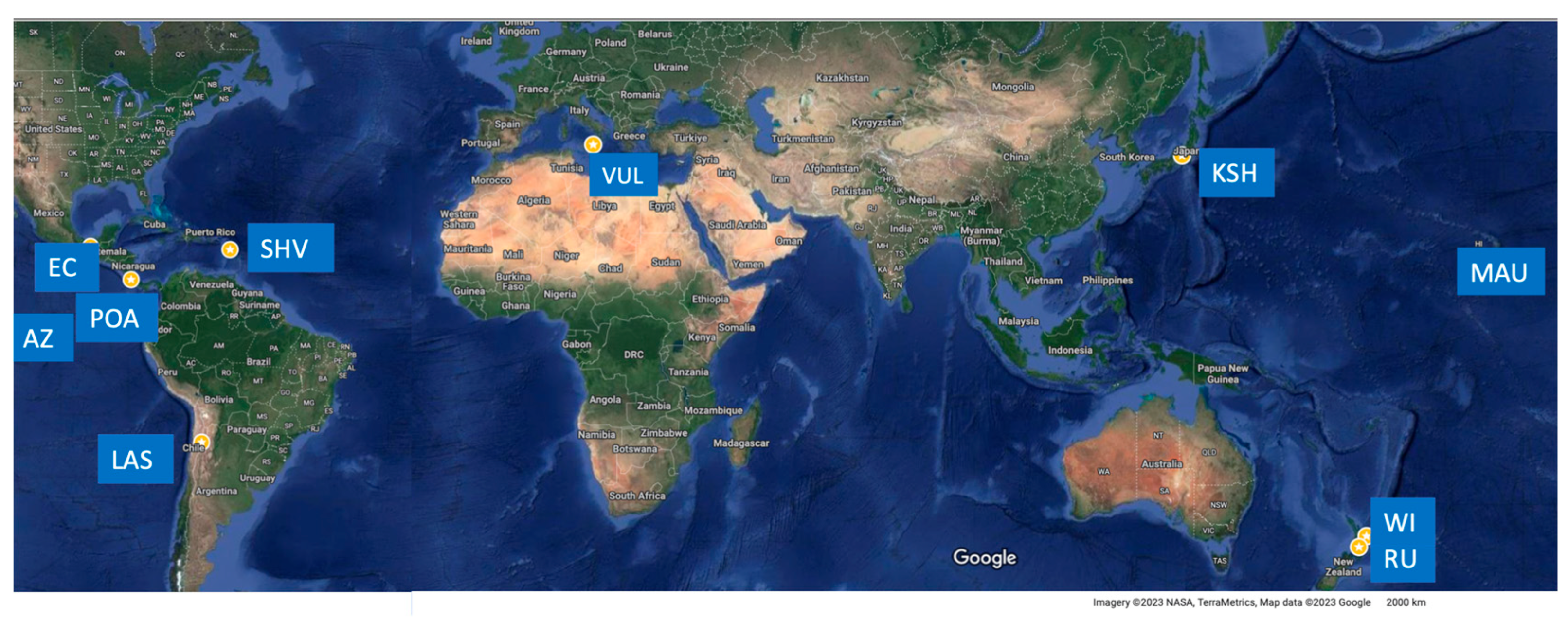
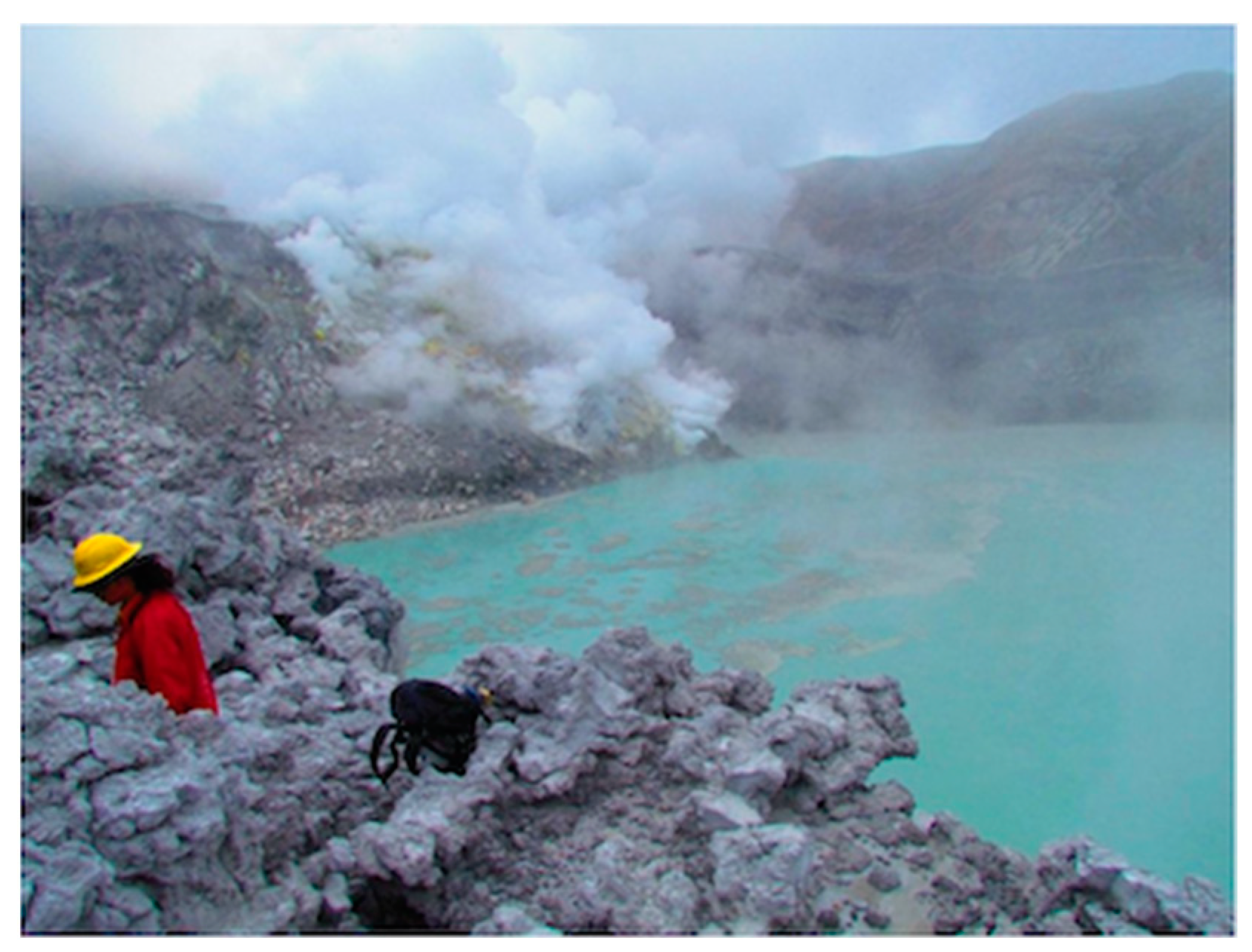
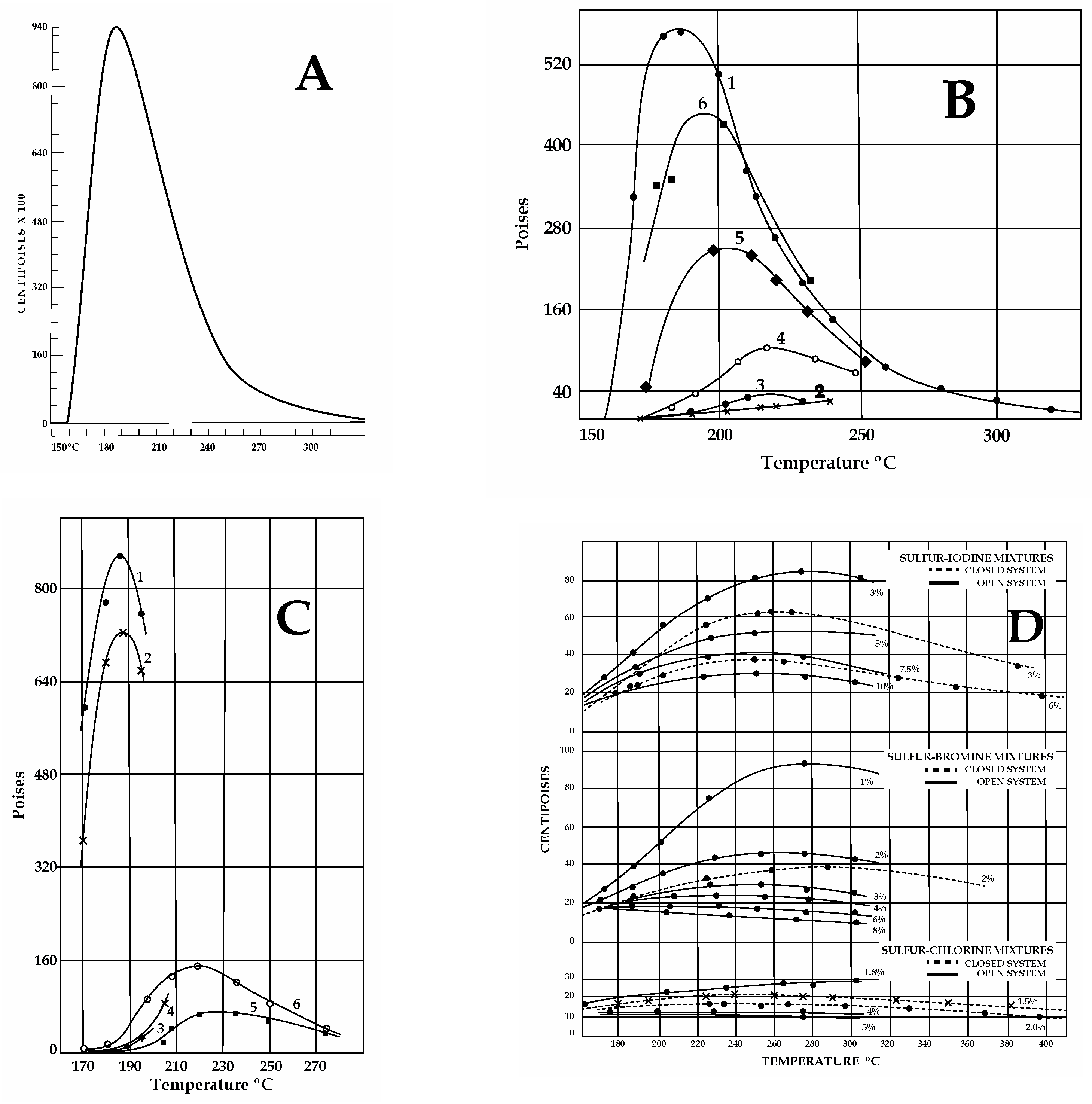
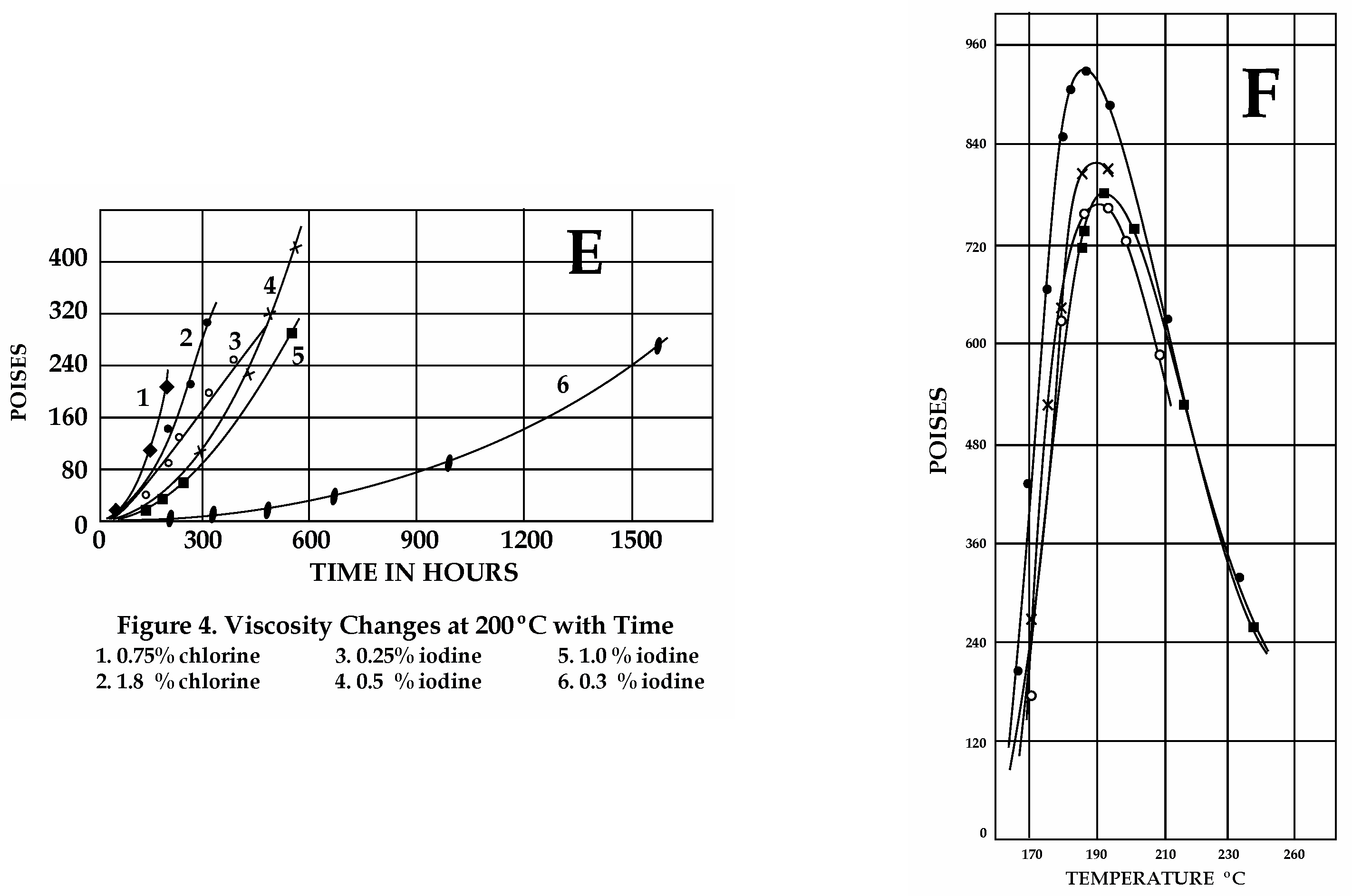
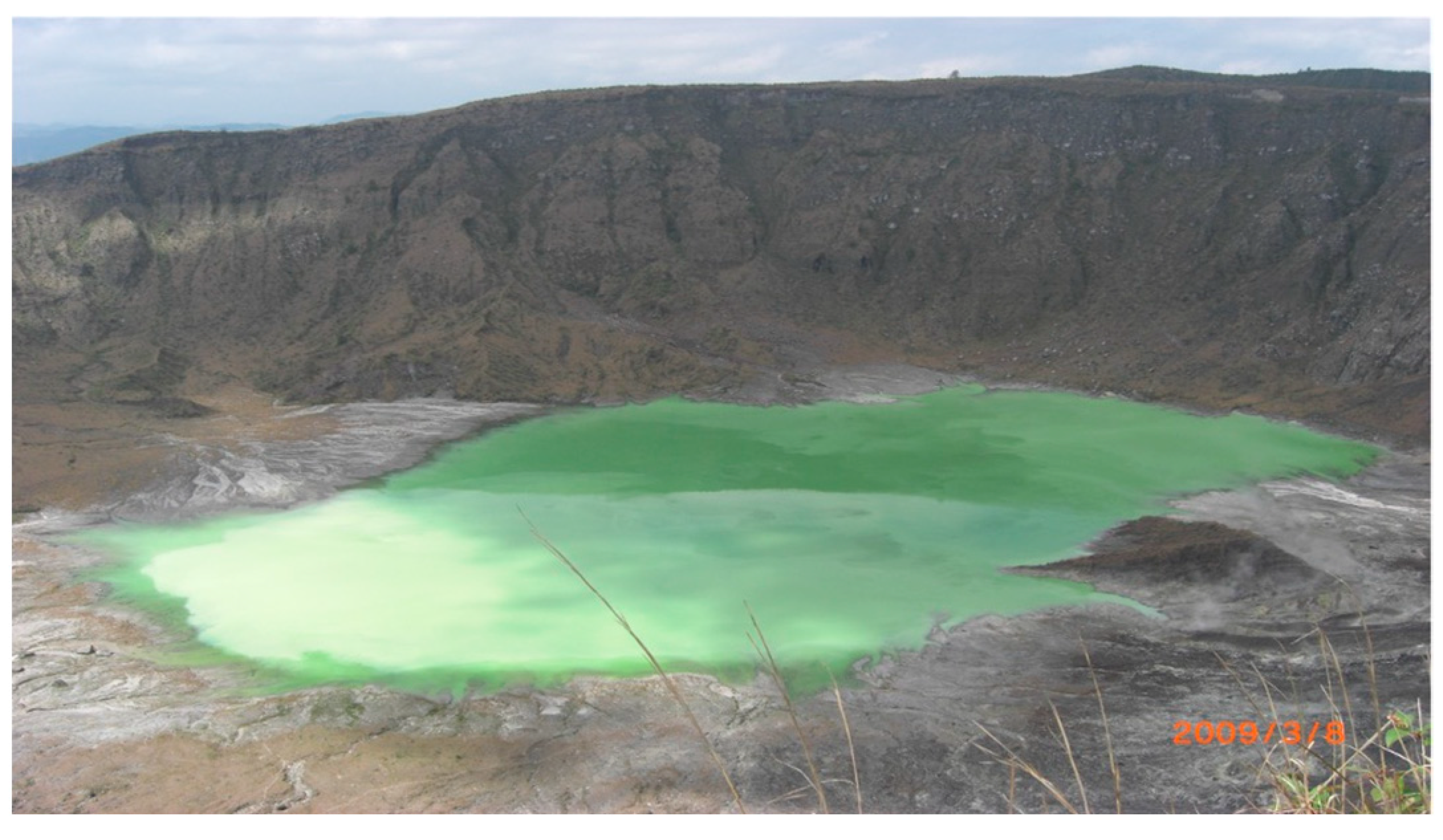
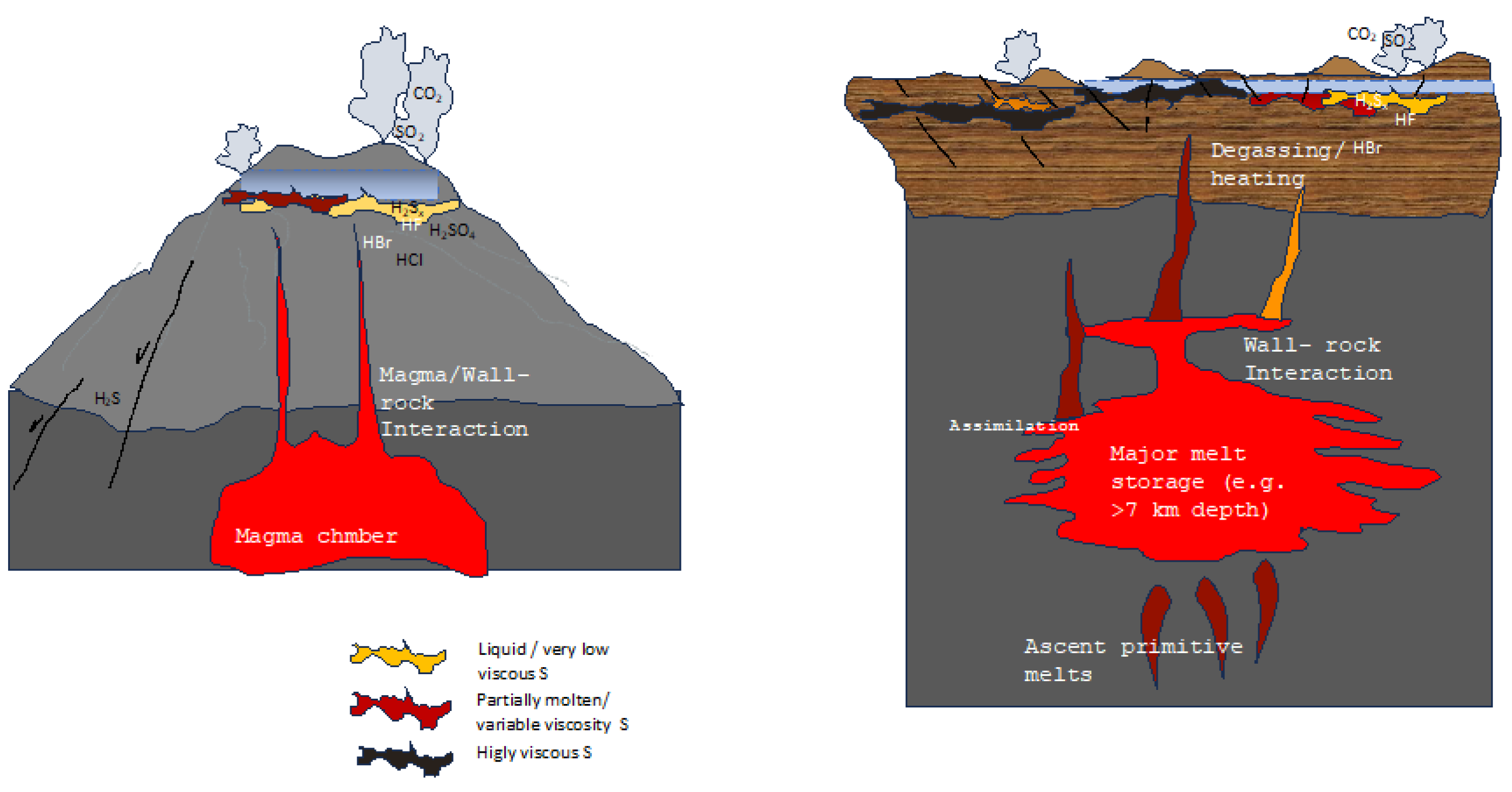
Disclaimer/Publisher’s Note: The statements, opinions and data contained in all publications are solely those of the individual author(s) and contributor(s) and not of MDPI and/or the editor(s). MDPI and/or the editor(s) disclaim responsibility for any injury to people or property resulting from any ideas, methods, instructions or products referred to in the content. |
© 2024 by the author. Licensee MDPI, Basel, Switzerland. This article is an open access article distributed under the terms and conditions of the Creative Commons Attribution (CC BY) license (https://creativecommons.org/licenses/by/4.0/).
Share and Cite
Scolamacchia, T. Sulfur Impurities: The Overlooked Process in Volcanic Hazard Assessment. Geosciences 2024, 14, 97. https://doi.org/10.3390/geosciences14040097
Scolamacchia T. Sulfur Impurities: The Overlooked Process in Volcanic Hazard Assessment. Geosciences. 2024; 14(4):97. https://doi.org/10.3390/geosciences14040097
Chicago/Turabian StyleScolamacchia, Teresa. 2024. "Sulfur Impurities: The Overlooked Process in Volcanic Hazard Assessment" Geosciences 14, no. 4: 97. https://doi.org/10.3390/geosciences14040097
APA StyleScolamacchia, T. (2024). Sulfur Impurities: The Overlooked Process in Volcanic Hazard Assessment. Geosciences, 14(4), 97. https://doi.org/10.3390/geosciences14040097






